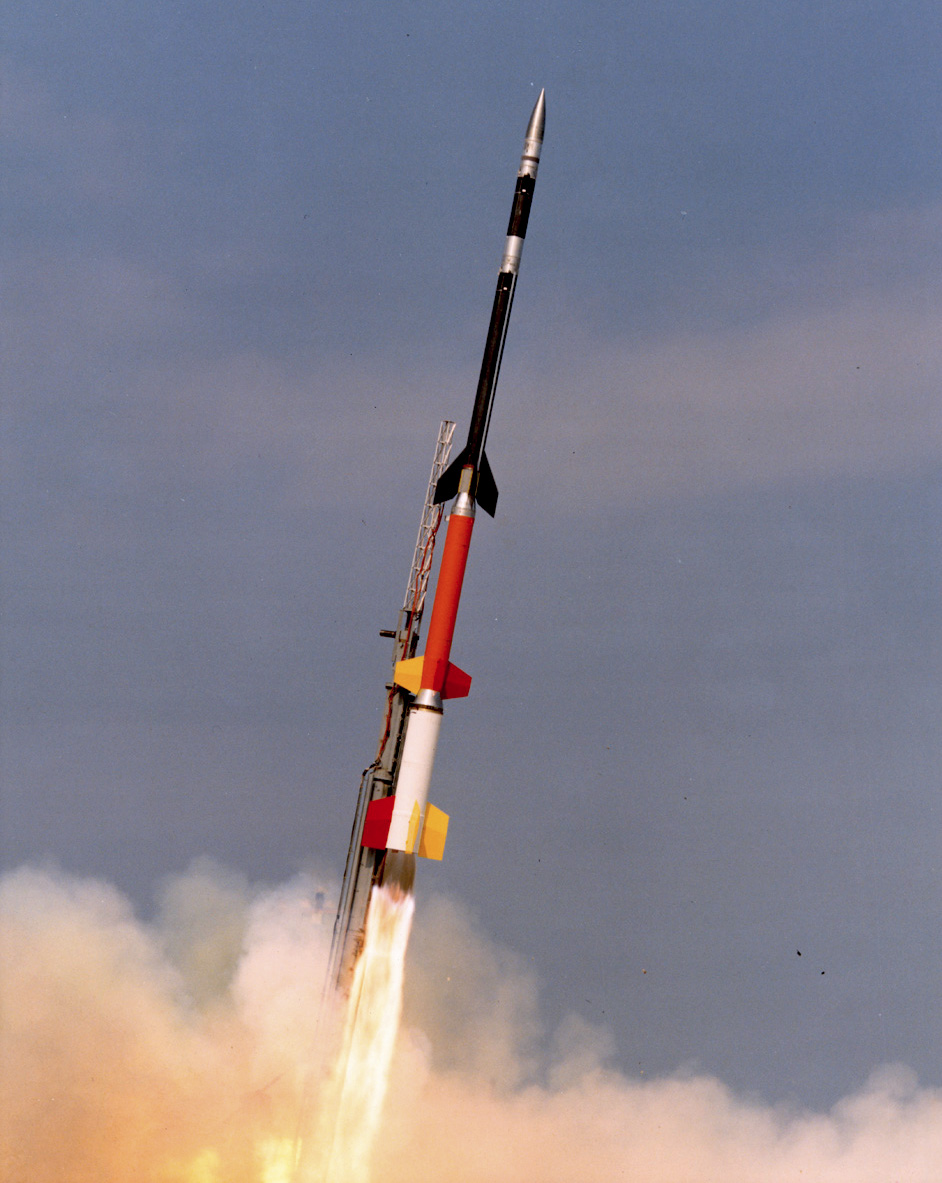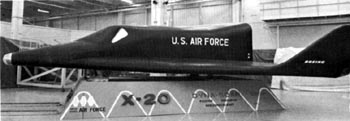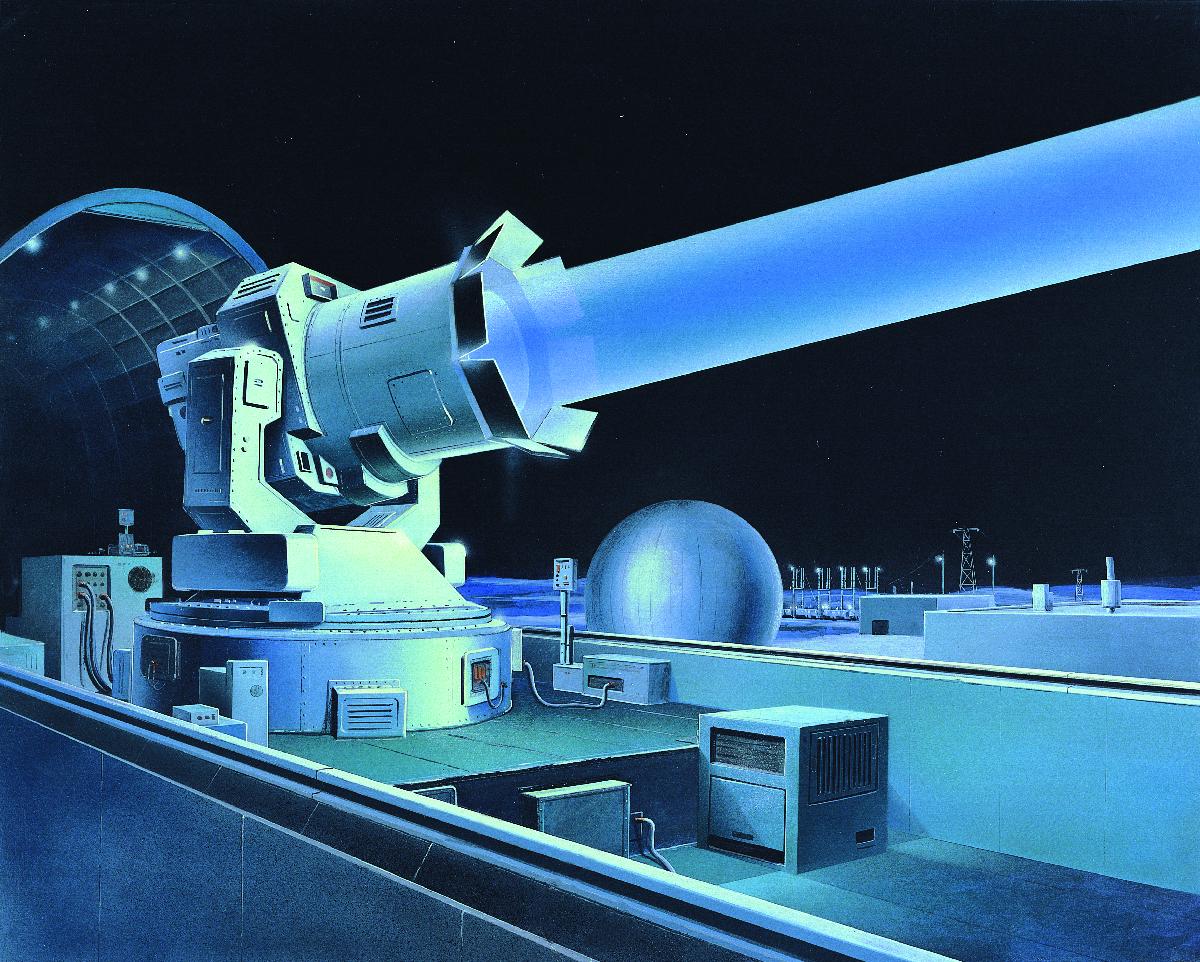|
Thor DSV-2
The Thor DSV-2 was a series of sounding rockets, test vehicles, and anti-satellite weapons derived from the Thor Intermediate-range ballistic missile. It was also used as the first stage of several Thor-derived expendable launch systems. Variants Thor DSV-2C Thor DSV-2D The DSV-2D was launched twice in 1962, conducting suborbital research flights for the development of the Program 437 ASAT. It was a single-stage vehicle, consisting of a Thor DM-21. Launches were conducted from Cape Canaveral Air Force Station Launch Complex 17A. Thor DSV-2E The DSV-2E was a single-stage vehicle, using a Thor DM-19. It was launched eight times in 1962, including several nuclear weapons tests as part of Operation Fishbowl. Three launches failed, all of which were carrying live nuclear warheads. Launches were conducted from Launch Emplacements 1 and 2 on Johnston Atoll. Thor DSV-2F The DSV-2F was a single-stage vehicle consisting of a Thor DM-19, like the DSV-2E. Three were launched between 196 ... [...More Info...] [...Related Items...] OR: [Wikipedia] [Google] [Baidu] |
Sounding Rocket
A sounding rocket or rocketsonde, sometimes called a research rocket or a suborbital rocket, is an instrument-carrying rocket designed to take measurements and perform scientific experiments during its sub-orbital flight. The rockets are used to launch instruments from 48 to 145 km (30 to 90 miles) above the surface of the Earth, the altitude generally between weather balloons and satellites; the maximum altitude for balloons is about 40 km (25 miles) and the minimum for satellites is approximately 121 km (75 miles). Certain sounding rockets have an apogee between 1,000 and 1,500 km (620 and 930 miles), such as the Black Brant X and XII, which is the maximum apogee of their class. Sounding rockets often use military surplus rocket motors. NASA routinely flies the Terrier Mk 70 boosted Improved Orion, lifting 270–450-kg (600–1,000-pound) payloads into the exoatmospheric region between 97 and 201 km (60 and 125 miles). Etymology The origin of the term ... [...More Info...] [...Related Items...] OR: [Wikipedia] [Google] [Baidu] |
Suborbital
A sub-orbital spaceflight is a spaceflight in which the spacecraft reaches outer space, but its trajectory intersects the atmosphere or surface of the gravitating body from which it was launched, so that it will not complete one orbital revolution (it does not become an artificial satellite) or reach escape velocity. For example, the path of an object launched from Earth that reaches the Kármán line (at ) above sea level), and then falls back to Earth, is considered a sub-orbital spaceflight. Some sub-orbital flights have been undertaken to test spacecraft and launch vehicles later intended for orbital spaceflight. Other vehicles are specifically designed only for sub-orbital flight; examples include crewed vehicles, such as the X-15 and SpaceShipOne, and uncrewed ones, such as ICBMs and sounding rockets. Flights which attain sufficient velocity to go into low Earth orbit, and then de-orbit before completing their first full orbit, are not considered sub-orbital. Exam ... [...More Info...] [...Related Items...] OR: [Wikipedia] [Google] [Baidu] |
Delta (rocket Stage)
Delta commonly refers to: * Delta (letter) (Δ or δ), a letter of the Greek alphabet * River delta, at a river mouth * D (NATO phonetic alphabet: "Delta") * Delta Air Lines, US * Delta variant of SARS-CoV-2 that causes COVID-19 Delta may also refer to: Places Canada * Delta, British Columbia ** Delta (electoral district), a federal electoral district ** Delta (provincial electoral district) * Delta, Ontario United States * Mississippi Delta * Delta, Alabama * Delta Junction, Alaska * Delta, Colorado * Delta, Illinois * Delta, Iowa * Delta, Kentucky * Delta, Louisiana * Delta, Missouri * Delta, North Carolina * Delta, Ohio * Delta, Pennsylvania * Sacramento–San Joaquin River Delta, California * Delta, Utah * Delta, Wisconsin, a town * Delta (community), Wisconsin * Delta County (other) Elsewhere * Delta Island, Antarctica * Delta Stream, Antarctica * Delta, Minas Gerais, Brazil * Nile Delta, Egypt * Delta, Thessaloniki, Greece * Delta State, Nigeria * Delta, Ast ... [...More Info...] [...Related Items...] OR: [Wikipedia] [Google] [Baidu] |
X-20 Dyna-Soar
The Boeing X-20 Dyna-Soar ("Dynamic Soarer") was a United States Air Force (USAF) program to develop a spaceplane that could be used for a variety of military missions, including aerial reconnaissance, bombing, space rescue, satellite maintenance, and as a space interceptor to sabotage enemy satellites. The program ran from October 24, 1957, to December 10, 1963, cost US$660 million ($ in current dollars), and was cancelled just after spacecraft construction had begun. Other spacecraft under development at the time, such as Mercury or Vostok, were space capsules with ballistic re-entry profiles that ended in a landing under a parachute. Dyna-Soar was more like an aircraft. It could travel to distant targets at the speed of an intercontinental ballistic missile, was designed to glide to Earth like an aircraft under control of a pilot, and could land at an airfield. Dyna-Soar could also reach Earth orbit, like conventional, manned space capsules. These characteristics mad ... [...More Info...] [...Related Items...] OR: [Wikipedia] [Google] [Baidu] |
ASSET (spacecraft)
ASSET, or Aerothermodynamic Elastic Structural Systems Environmental Tests was an experimental US space project involving the testing of an uncrewed sub-scale reentry vehicle. Development and testing Begun in 1960, ASSET was originally designed to verify the superalloy heat shield of the X-20 Dyna-Soar prior to full-scale crewed flights. The vehicle's biconic shape and low delta wing were intended to represent Dyna-Soar's forward nose section, where the aerodynamic heating would be the most intense; in excess of an estimated 2200 °C (4000 °F) at the nose cap. Following the X-20 program's cancellation in December 1963, completed ASSET vehicles were used in reentry heating and structural investigations with hopes that data gathered would be useful for the development of future space vehicles, such as the Space Shuttle. Built by McDonnell, each vehicle was launched on a suborbital trajectory from Cape Canaveral's Pad 17B at speeds of up to 6000 m/s before ma ... [...More Info...] [...Related Items...] OR: [Wikipedia] [Google] [Baidu] |
ASSET THOR
In financial accounting, an asset is any resource owned or controlled by a business or an economic entity. It is anything (tangible or intangible) that can be used to produce positive economic value. Assets represent value of ownership that can be converted into cash (although cash itself is also considered an asset). The balance sheet of a firm records the monetaryThere are different methods of assessing the monetary value of the assets recorded on the Balance Sheet. In some cases, the ''Historical Cost'' is used; such that the value of the asset when it was bought in the past is used as the monetary value. In other instances, the present fair market value of the asset is used to determine the value shown on the balance sheet. value of the assets owned by that firm. It covers money and other valuables belonging to an individual or to a business. Assets can be grouped into two major classes: tangible assets and intangible assets. Tangible assets contain various subclasses, includ ... [...More Info...] [...Related Items...] OR: [Wikipedia] [Google] [Baidu] |
Nuclear Warhead
A nuclear weapon is an explosive device that derives its destructive force from nuclear reactions, either fission (fission bomb) or a combination of fission and fusion reactions (thermonuclear bomb), producing a nuclear explosion. Both bomb types release large quantities of energy from relatively small amounts of matter. The first test of a fission ("atomic") bomb released an amount of energy approximately equal to . The first thermonuclear ("hydrogen") bomb test released energy approximately equal to . Nuclear bombs have had yields between 10 tons TNT (the W54) and 50 megatons for the Tsar Bomba (see TNT equivalent). A thermonuclear weapon weighing as little as can release energy equal to more than . A nuclear device no larger than a conventional bomb can devastate an entire city by blast, fire, and radiation. Since they are weapons of mass destruction, the proliferation of nuclear weapons is a focus of international relations policy. Nuclear weapons have been deployed ... [...More Info...] [...Related Items...] OR: [Wikipedia] [Google] [Baidu] |
Operation Dominic I And II
Operation Dominic was a series of 31 nuclear test explosions with a total yield conducted in 1962 by the United States in the Pacific. This test series was scheduled quickly, in order to respond in kind to the Soviet resumption of testing after the tacit 1958–1961 test moratorium. Most of these shots were conducted with free-fall bombs dropped from B-52 bomber aircraft. Twenty of these shots were to test new weapons designs; six to test weapons effects; and several shots to confirm the reliability of existing weapons. The Thor missile was also used to lift warheads into near-space to conduct high-altitude nuclear explosion tests; these shots were collectively called Operation Fishbowl. Operation Dominic occurred during a period of high Cold War tension between the United States and the Soviet Union, since the Cuban Bay of Pigs Invasion had occurred not long before. Nikita Khrushchev announced the end of a three-year moratorium on nuclear testing on 30 August 1961, and Sovi ... [...More Info...] [...Related Items...] OR: [Wikipedia] [Google] [Baidu] |
Nuclear Weapon
A nuclear weapon is an explosive device that derives its destructive force from nuclear reactions, either fission (fission bomb) or a combination of fission and fusion reactions ( thermonuclear bomb), producing a nuclear explosion. Both bomb types release large quantities of energy from relatively small amounts of matter. The first test of a fission ("atomic") bomb released an amount of energy approximately equal to . The first thermonuclear ("hydrogen") bomb test released energy approximately equal to . Nuclear bombs have had yields between 10 tons TNT (the W54) and 50 megatons for the Tsar Bomba (see TNT equivalent). A thermonuclear weapon weighing as little as can release energy equal to more than . A nuclear device no larger than a conventional bomb can devastate an entire city by blast, fire, and radiation. Since they are weapons of mass destruction, the proliferation of nuclear weapons is a focus of international relations policy. Nuclear weapons have been d ... [...More Info...] [...Related Items...] OR: [Wikipedia] [Google] [Baidu] |
Program 437
Program 437 was the second anti-satellite weapons program of the U.S. military.Peebles, Curtis. "High Frontier: The United States Air Force and the Military Space Program", 1997 The US anti-satellite weapons program began development in the early 1960s and was officially discontinued on 1 April 1975. Program 437 was approved for development by U.S. Secretary of Defense Robert McNamara on November 20, 1962, after a series of tests involving high altitude nuclear explosions. The program's facilities were located on Johnston Island, an isolated island in the north central Pacific Ocean. History The US's first anti-satellite system was Program 505, based at the Kwajalein Missile Range, about halfway between Hawaii and the Philippine islands. This system became operational in 1962, based on the Nike Zeus anti-ballistic missile that had been tested at that site. These missiles had been modified for greater range, but even with these modifications the system could only intercept sa ... [...More Info...] [...Related Items...] OR: [Wikipedia] [Google] [Baidu] |
Expendable Launch System
An expendable launch system (or expendable launch vehicle/ELV) is a launch vehicle that can be launched only once, after which its components are either destroyed during reentry or discarded in space. ELVs typically consist of several rocket stages that are discarded sequentially as their fuel is exhausted and the vehicle gains altitude and speed. As of 2022, most satellites and human spacecraft are currently launched on ELVs. ELVs are simpler in design than reusable launch systems and therefore may have a lower production cost. Furthermore, an ELV can use its entire fuel supply to accelerate its payload, offering greater payloads. ELVs are proven technology in widespread use for many decades. ELVs are usable only once, and therefore have a significantly higher per-launch cost than modern (post-STS) reusable vehicles. Current operators Arianespace China ISRO JAXA Roscosmos United States Several governmental agencies of the United States purchase ELV launches. NASA is ... [...More Info...] [...Related Items...] OR: [Wikipedia] [Google] [Baidu] |
Anti-satellite Weapon
Anti-satellite weapons (ASAT) are space weapons designed to incapacitate or destroy satellites for strategic or tactical purposes. Several nations possess operational ASAT systems. Although no ASAT system has been utilised in warfare, a few countries (China, India, Russia, United Kingdom and the United States) have successfully shot down their own satellites to demonstrate their ASAT capabilities in a show of force. ASATs have also been used to remove decommissioned satellites. ASAT roles include: defensive measures against an adversary's space-based and nuclear weapons, a force multiplier for a nuclear first strike, a countermeasure against an adversary's anti-ballistic missile defence (ABM), an asymmetric counter to a technologically superior adversary, and a counter-value weapon. Use of ASATs generates space debris, which can collide with other satellites and generate more space debris. A cascading multiplication of space debris could cause Earth to suffer from Ke ... [...More Info...] [...Related Items...] OR: [Wikipedia] [Google] [Baidu] |






